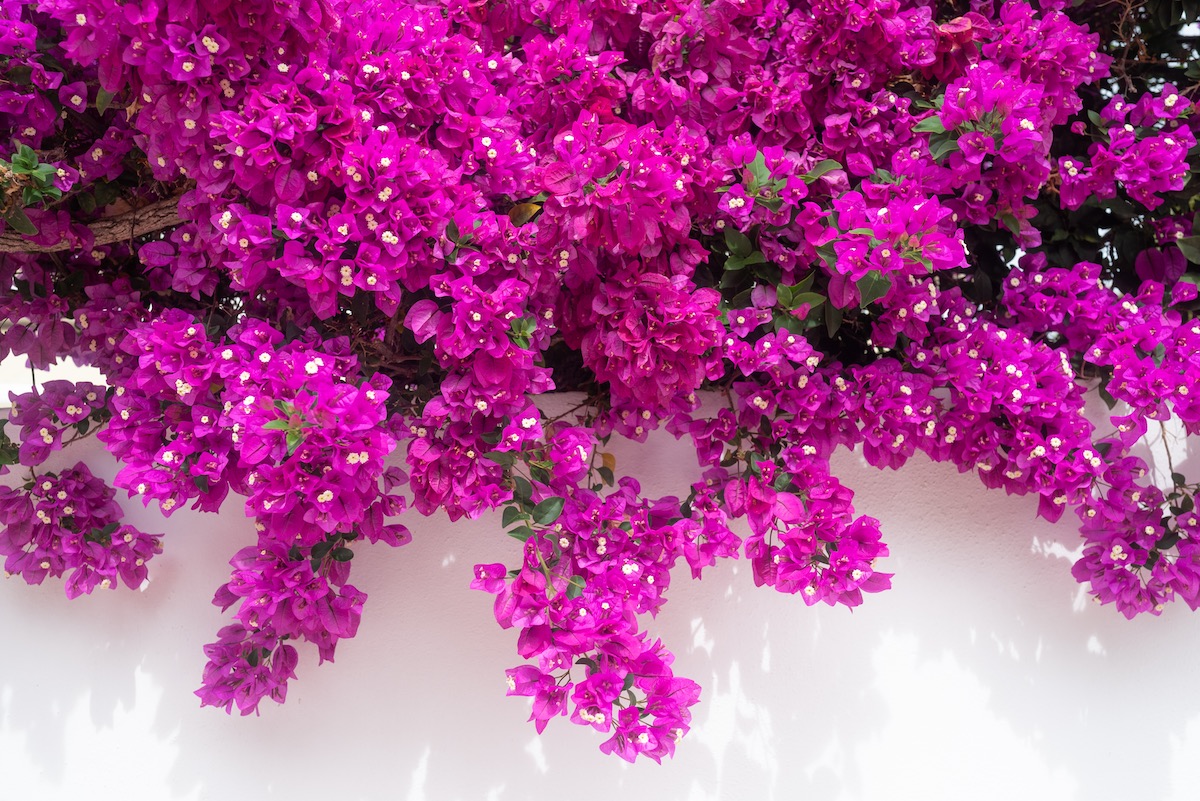
Photo by Amovitania
Bright bougainvillea blossoms spill over a garden wall.
Talk about instant associations: Nothing says the tropics like a bougainvillea. In festive, colorful, put-on-your-sunglasses terms, everything about the sun-drenched warmth of temperate regions is summed up in the massive girth of this drop-dead gorgeous vine that drapes its support in voluptuous bracts. The papery texture feels like suspended confetti, the racy colors glisten in varying hues in the sunlight, and the prolonged performance earns this vine bonus points with backyard gardeners. In short, a bougainvillea’s durability is legendary.
Designed to impress (nobody walks by a bougainvillea), this bloomer demands attention. Most bougainvilleas are plus-sized vines that climb via lax woody stems requiring support. Their heft is part of their signature style—they are as bold as it comes in the floral kingdom, but they also perform well in containers.
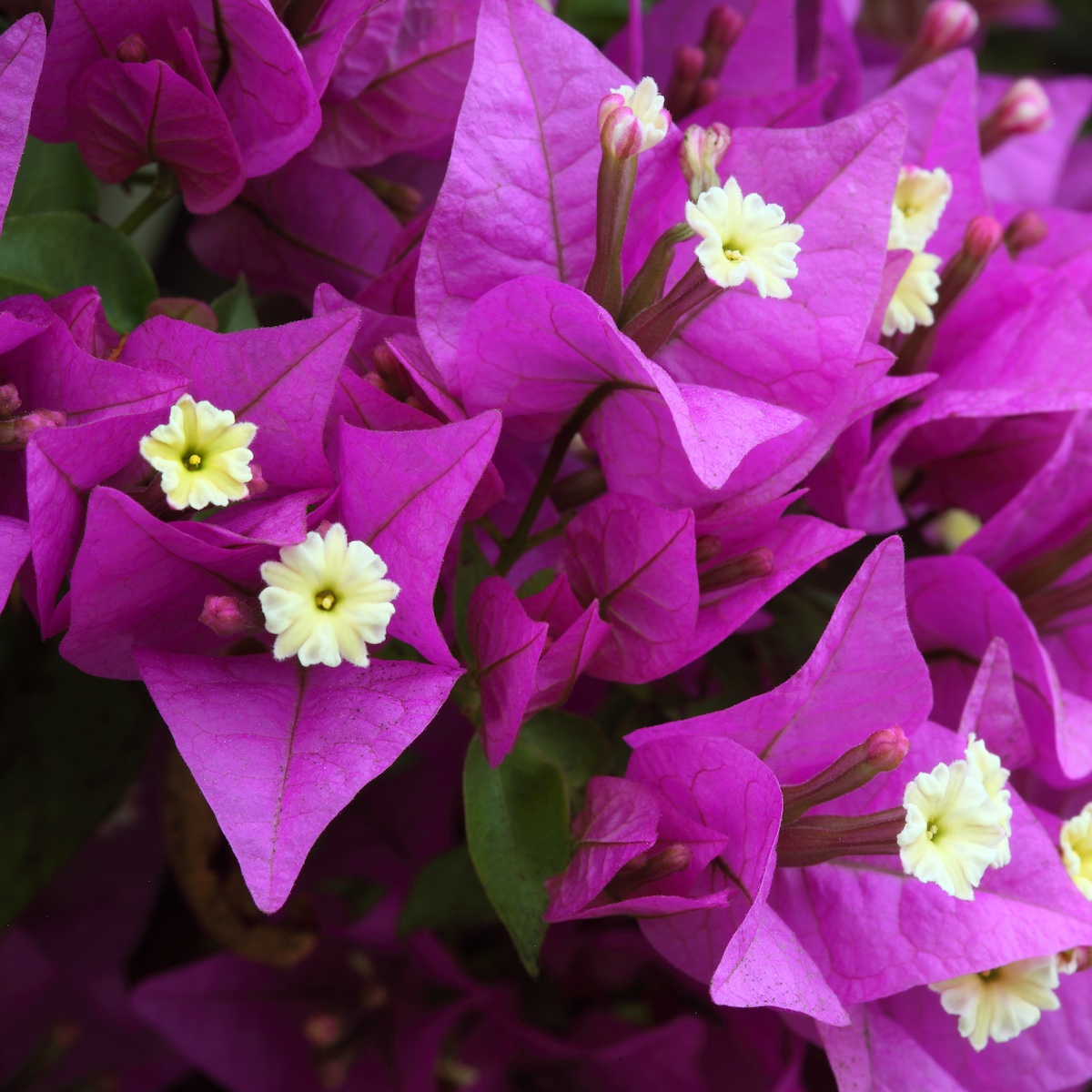
Photo courtesy of Monrovia
Bougainvillea flowers are tiny trumpet-shaped blossoms surrounded by the showy, papery bracts that command attention.
Just to define precisely what part of the shebang is catching your attention: The actual flower of a bougainvillea is shaped like a thin, small tube and is not particularly noteworthy in this member of the Nyctaginacaea, the same family that hosts four o’clocks (Mirabilis). Native to tropical and subtropical South America, the plant has papery bracts surrounding those flowers that set the heart aflutter. The bracts come in startling colors from red to magenta, orange, peach, yellow, purple, and white. They linger long and then float poetically to the ground. It’s a lovely package.

Photo by Doreen Wynja, courtesy of Monrovia
Bougainvillea 'Raspberry Ice' contrasts bright pink bracts with variegated leaves.
But then, it gets better. There’s a trend to get the elliptic foliage into the act, so variegated cream and golden leaves are becoming part of the display—and now there’s even a burgundy-leafed player.
CARING FOR BOUGAINVILLEA
If you want to flaunt the fact that your zone is temperate (we’re talking Zone 10 or warmer), then send off your holiday cards in November with the family posing in front of your bougainvillea. Nobody will need to ask the identity of the backdrop because bougainvilleas have universal appeal. In regions where they thrive, bougainvilleas are frequently installed as floral attractions. According to Tracy Harrison, Monrovia’s production planning manager who has been growing bougainvilleas for the company for 20+ years, temperatures that remain above 55° F are optimal for bougainvilleas. “They can tolerate colder temperatures, but bougainvilleas drop leaves when temperatures dip to 40°,” he says. On the other hand, heat is no problem. “When the temperatures shoot to 100° plus, bougainvilleas are fine, but the lack of air flow in a humid environment can be an issue.” That’s why ultra-humid greenhouses can spell trouble (and leaf drop) for bougainvilleas. However, given brisk air circulation, they’ll be fine.
WATERING: According to Tracy Harrison, the primary trick to success with bougainvilleas is turning the other cheek rather than pouring on the water. “They’re tough plants that are hard to kill, but too wet is definitely not good,” he warns. How does a bougainvillea express its disdain for overwatering? By dropping leaves or floral bracts. On the other hand, this deceptively tough vine can endure a slight wilt without batting an eyelash and even respond with a flush of fresh flowers after mild wilting.
FERTILIZING: Similarly, resist the urge to overfeed your bougainvillea. They enjoy and respond to fertilizer, but given too much nitrogen, a bougainvillea will produce abundant greenery but scant flowering bracts. “Dialing back the nitrogen” can be translated into a 3-4-5 fertilizer, and like the trick of withholding water, a shot of fertilizer can jumpstart bud production.
PRUNING: Another cue that rouses buds is pruning a bougainvillea. “Prune it back really hard and it will respond with a flush of flowers,” Tracy urges. Be careful—the stems have sizable barbs (aka thorns), and that’s something you should keep in mind when cutting and before planting a bougainvillea anywhere near a door or heavy-traffic area on your property. In fact, a dermatological reaction is possible. However, variegated versions tend to produce fewer thorns.
LIGHT REQUIREMENTS: In addition, bright light is imperative. “Face a bougainvillea to the southwest or anywhere it will enjoy full sun for most of the day,” Tracy suggests. “However, it will do fine with some early morning and late afternoon shade.”
GROWING BOUGAINVILLEA IN CONTAINERS
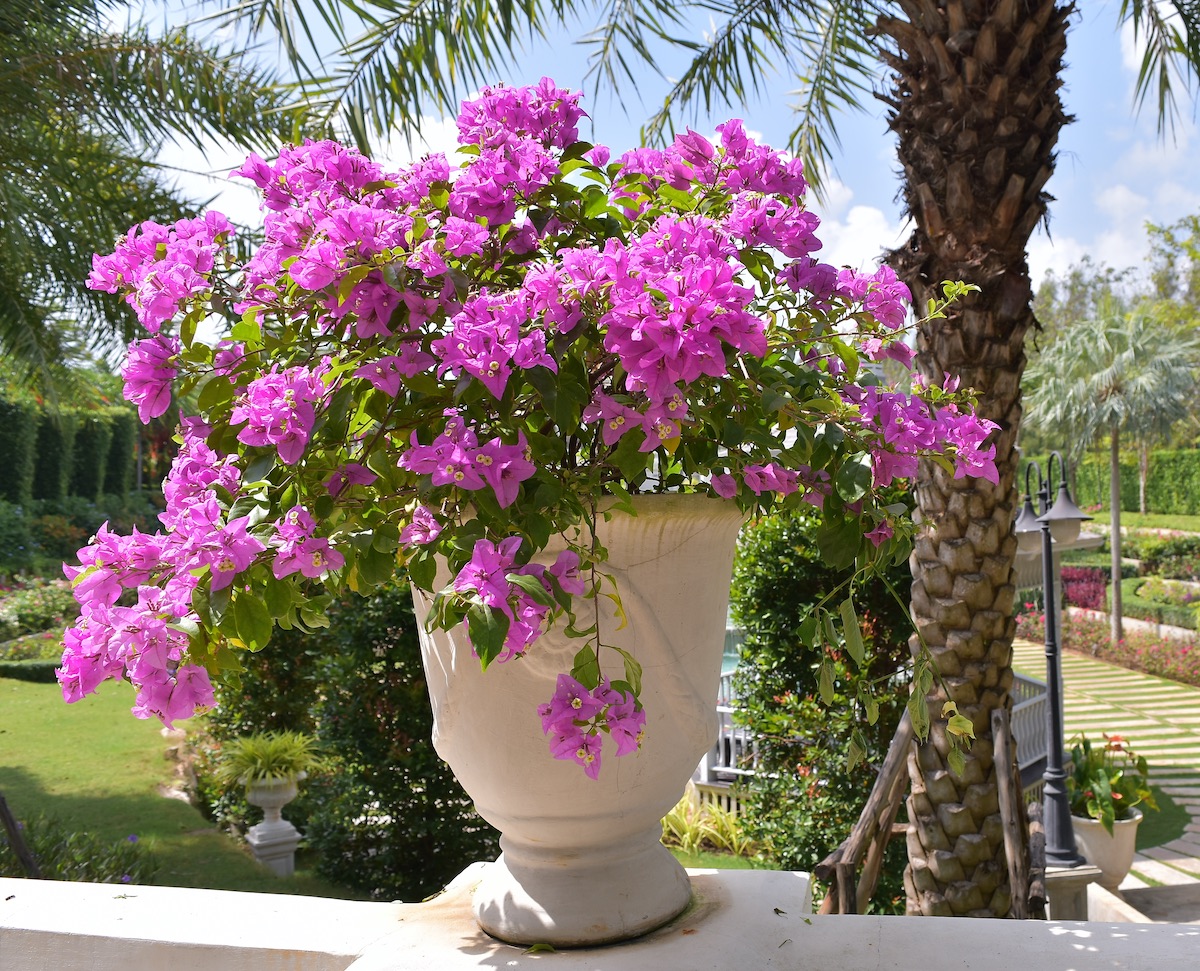
Photo by Mr. Natthawut
This pink bougainvillea fills a garden urn.
The wonderful little secret about bougainvilleas is that they are easy to host as potted plants. “They grow happily in a container for a long time,” Tracy Harrison says. “I’ve got a bougainvillea growing in a 5-gallon container since 2014!” In fact, bougainvilleas are occasionally sculpted into bonsai. More commonly, bougainvilleas are shaped into various topiary forms, trained into tree form, or coaxed to form a cascading shower of blooming branches by guiding the stems up a trellis. The trick lies in keeping the top-heavy crown from toppling, so a redwood stake would be a good idea. Espaliered bougainvilleas are an artistic expression sometimes seen, and patio accents are a common role for this plant.
Happily, bougainvilleas are not only for those who dwell in Zone 10 and warmer. For everyone who dreams of the tropics, you can realistically grow bougainvillea in a container sheltered indoors. Amazingly, bougainvilleas can be hosted as houseplants. Granted, you’ll need to invest some space in the project, but for anybody who wants to create a sense of the tropics, bougainvilleas are within your realm. You’ll need a large, sunny, south-facing window; a greenhouse would be an even better idea. But if you’ve got those requisites, the whole heady bougainvillea experience can be yours.
You can also treat bougainvilleas as annuals, enjoying their show through the summer and replacing them each year. In a particularly sunny spot, you can expect up to five feet of growth in a season.
BOUGAINVILLEA FLOWER ARRANGEMENTS
Bougainvillea branches can be cut for arrangements and used as filler flowers. Cut or hammer the woody stem ends to help them draw water from the container. Cut flowers will last 2-3 days.
While it may seem unlikely that the tropical bracts could hold up for bouquets, Elizabeth B.H. Montgomery of Three Toads Farm in Winchester, Kentucky proved otherwise. When challenged to use bougainvillea in wedding flowers, she tested six methods for conditioning them. Cutting a tendril and holding it overnight in the cooler was as effective as her other approaches. Elizabeth notes that double-flowered varieties did not hold up as well as singles.
While their color will fade, dried bougainvillea branches make striking additions to arrangements, and their papery texture is foliage-like.
BOUGAINVILLEA VARIETIES & COLORS
We usually associate outrageous color with bougainvilleas, and a few mainstays have dominated the vivid hue market for years. Plus, the beauty of these saturated shades is that some work remarkably well in tandem.

Photo by Doreen Wynja, courtesy of Monrovia
Bengal Orange Bougainvillea

Photo by Doreen Wynja, courtesy of Monrovia
Camarillo Fiesta™ Bougainvillea
Take ‘Bengal Orange’ for example—its creamy foliage covered in pinkish-orange bracts reads smartly beside the orange-peach bracts of ‘Camarillo Fiesta’™.
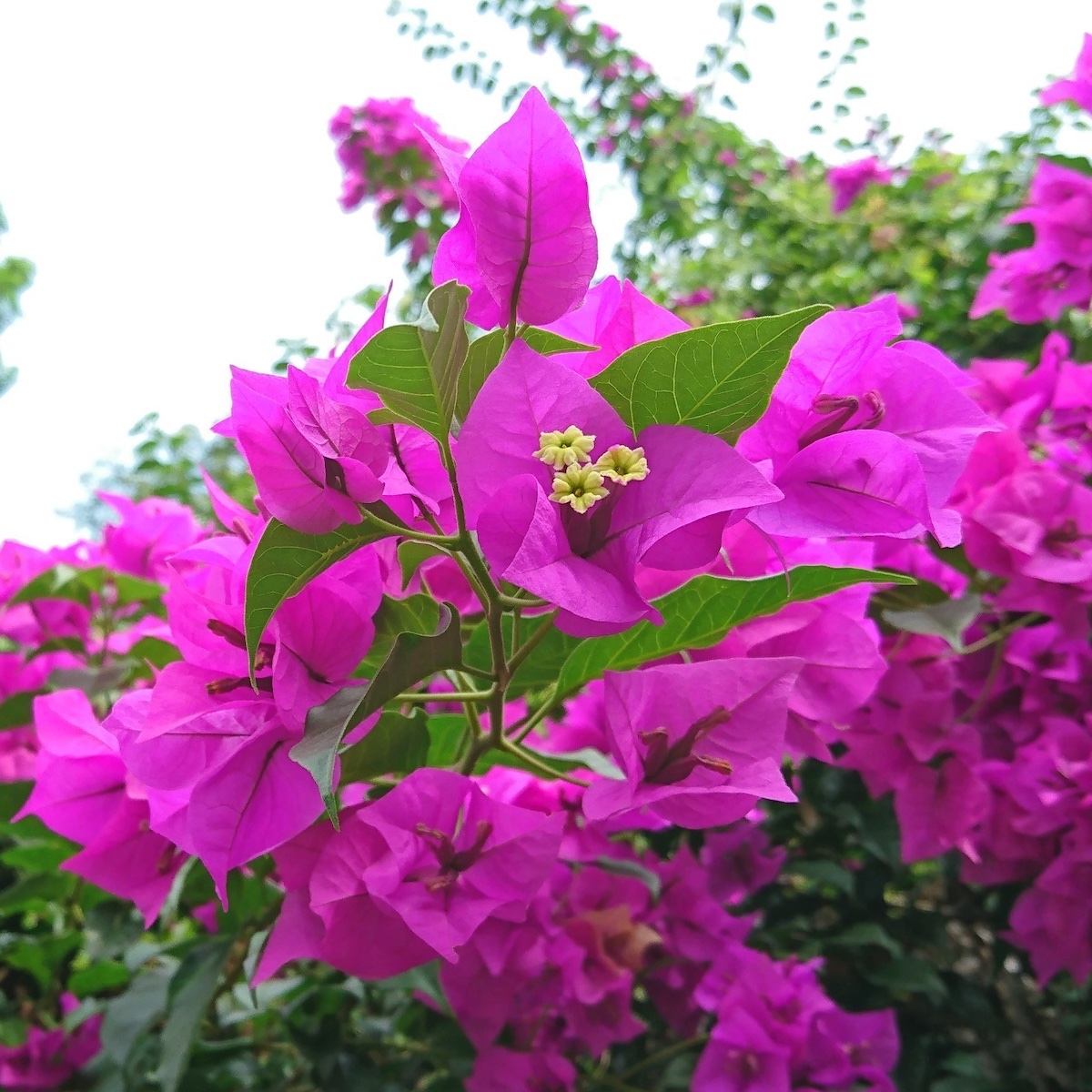
Photo by Cheng Wei
Elizabeth Angus Bougainvillea
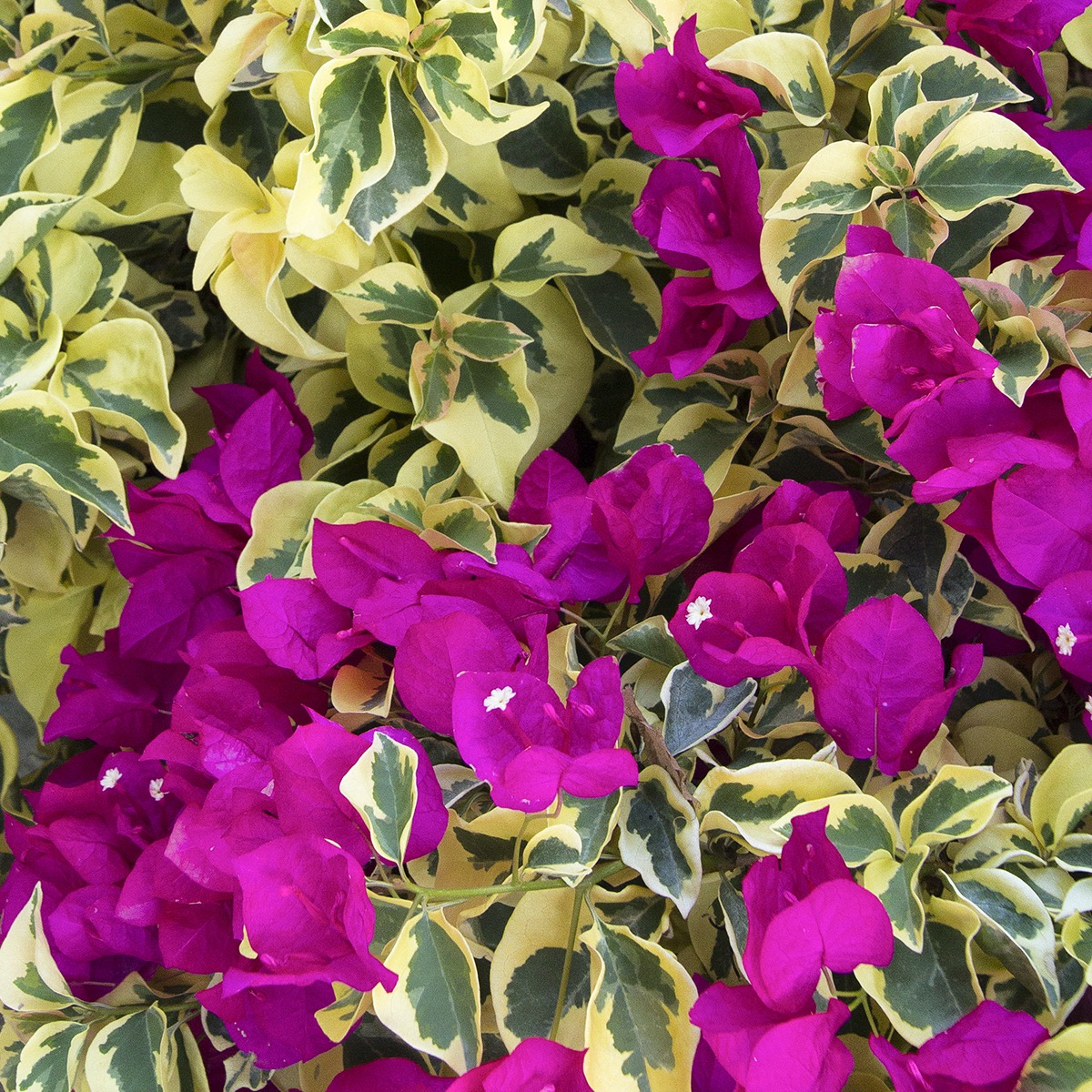
Photo by Doreen Wynja, courtesy of Monrovia
Raspberry Ice Bougainvillea
‘Elizabeth Angus’ is bedecked in purplish-magenta bracts that would pair nicely with the purple bracts of ‘Raspberry Ice,’ as well as its cream variegated foliage. Plus ‘Raspberry Ice’ has slightly less volume, also leading to a happy marriage with a more robust, non-variegated partner.

Photo by Stacy O
Barbara Karst Bougainvillea
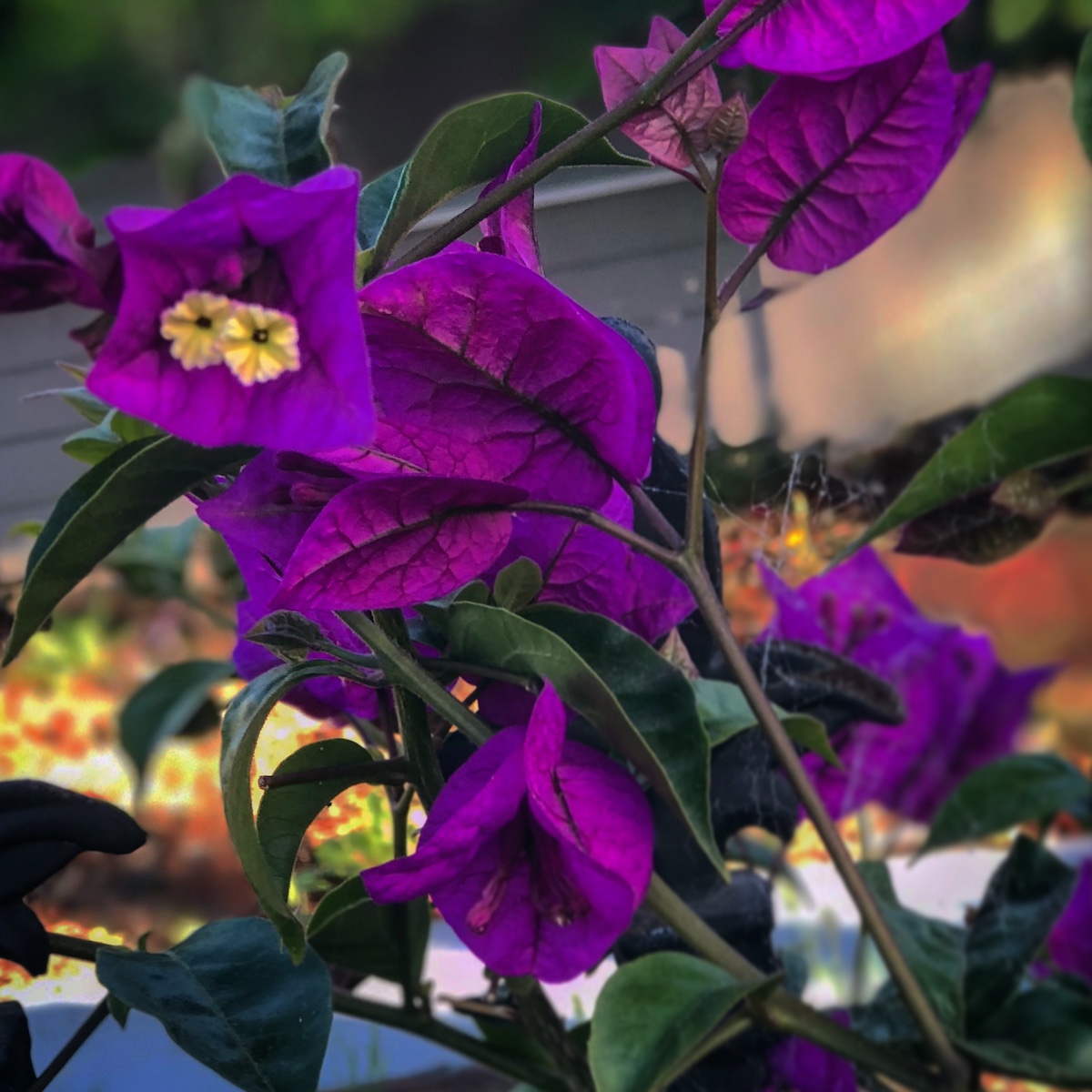
Photo by Jessica Tellez
Purple Queen Bougainvillea
On the energetic side, ‘Barbara Karst’ is a super-athlete with fuchsia red flowers. She can quickly transform a site into a spectacle, rating as the bougainvillea’s version of an extreme climber capable of reaching heights. Compared to her sheer vigor, ‘Purple Queen®’ is relatively tame with rich, royal purple bracts, winning it the designation as the most popular bougainvillea on the market.
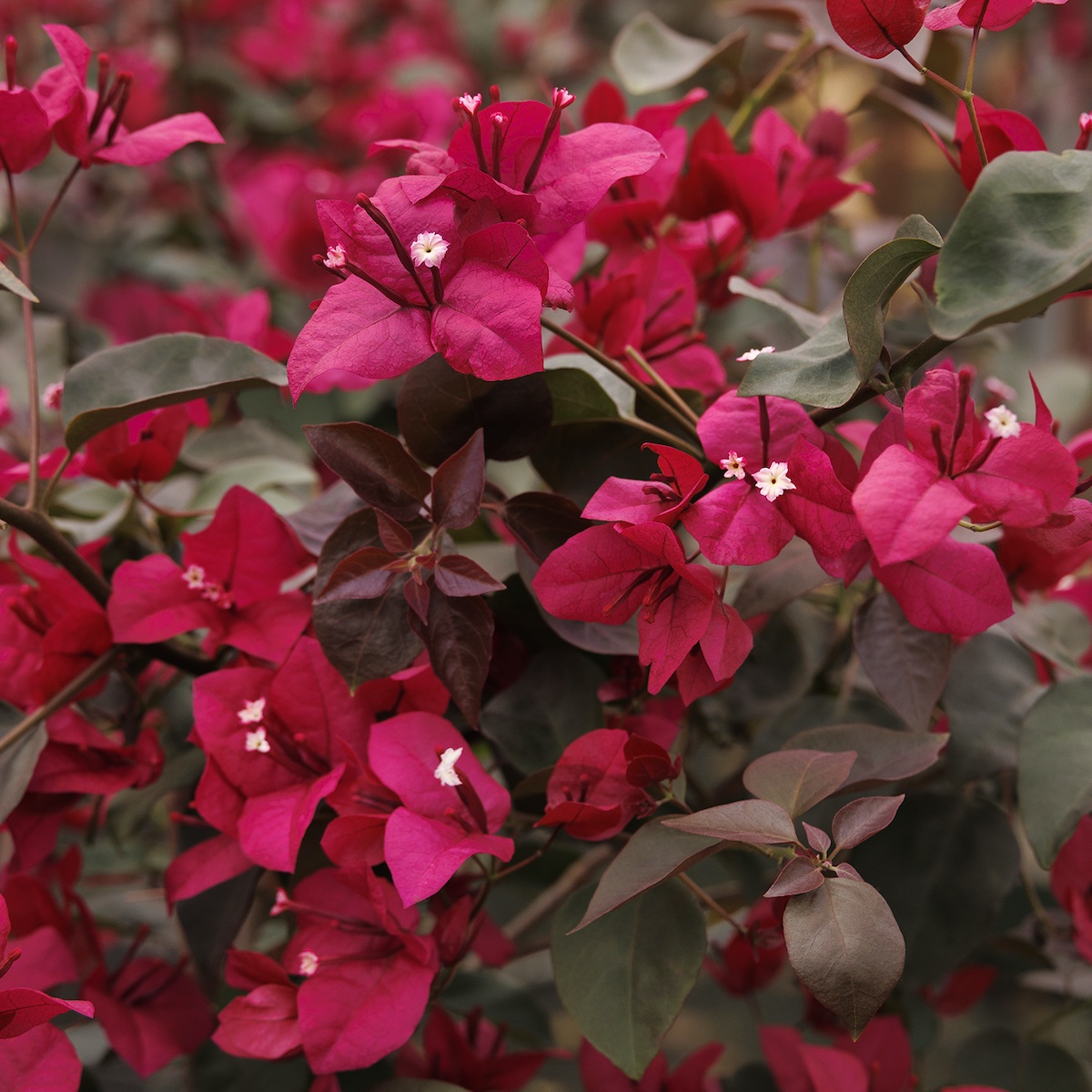
Photo by Brandon-Friend Solis, Courtesy of Monrovia
Burgundy Queen® Bougainvillea
Burgundy Queen® Bougainvillea brings two times the drama with rich burgundy and new foliage that appears in a deep wine coloration. Monrovia’s Tracy Harrison discovered the plant as a sport on the company’s farm in Cairo, Georgia.
Meanwhile, if a tropical snowstorm of white with just a hint of blush is your fantasy, go for ‘Double White’—with the bonus that double bracts cling longer without shattering.
All bougainvilleas are eye candy and just what you crave when you think of warm climates. So kick back and imagine life surrounded by your own privacy screen of papery color. Dream on…






